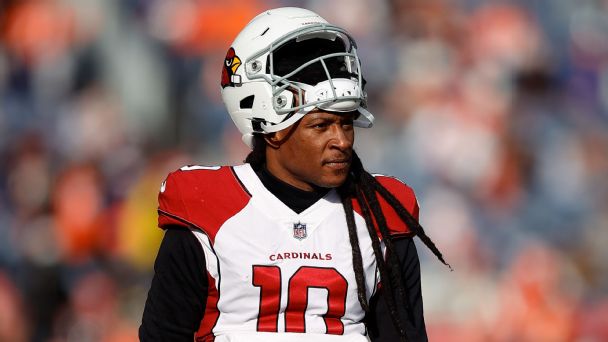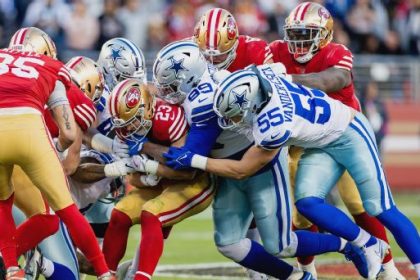
PHOENIX — The biggest question surrounding the Arizona Cardinals coming out of the NFL owners meeting earlier this week was whether wide receiver DeAndre Hopkins will be traded — and, if so, to whom.
His $30.75 million cap hit for 2023 is the highest on the team, as well as among wide receivers in the NFL, and is also the seventh highest in the league among all positions.
If the Cardinals’ goal is to reduce their overall cap number, they have a couple of options with the 30-year-old Hopkins: trade him or — one possibility that’s not being discussed publicly as much — release him as a post-June 1 designation.
Then there’s the third option: keep him.
Here’s a look at some of the most pressing questions about the Hopkins’ situation:
Where does a potential Hopkins trade stand?
Cardinals coach Jonathan Gannon said Tuesday he’s working under the premise that Hopkins will be his X receiver (lined up on the opposite side of the field as the tight end) and is looking forward to working with Hopkins. While a public declaration from a coach about a player doesn’t mean anything is set in stone (read: former coach Kliff Kingsbury saying 2018 first-round quarterback Josh Rosen was “our guy” in February 2019, months before the Cardinals drafted quarterback Kyler Murray No. 1 overall), an on-the-record comment from a coach about that player does carry a bit of weight.
On the other hand, general manager Monti Ossenfort said he had had “a conversation with DeAndre and DeAndre’s representatives” when asked about a potential trade at the scouting combine last month. The Cardinals have reportedly given teams permission to talk with Hopkins about a trade.
Why would the Cardinals trade Hopkins, and what would it say about their rebuild?
As of now, the Cardinals are set to take on Hopkins’ $30.75 million cap hit in 2023, which would be a major blow to their ability to build out their roster in ways that would make them competitive. Moving him or releasing him would give them more cap freedom, which could, potentially, help them add players in the long run.
Moving on from Hopkins, who led the Cardinals in receiving yards (717) last season despite playing in only nine games, would be the signal — not a signal, the signal — that a full rebuild is in progress. Taking him out of the offensive picture would mean Arizona loses its WR1 and a critical player in its offensive scheme who dictates how teams defend the Cardinals.
What would it mean for their salary cap?
A trade would save the Cardinals $8.15 million in cap space but would leave Arizona with $22.6 million in dead money. However, either releasing Hopkins after June 1 or releasing him before that and designating him as a post-June 1 release would save the Cardinals’ $19.45 million in cap space. But releasing him means Arizona would not get anything tangible in return for a receiver who ranks No. 7 in receiving yards (5,433) over the past five seasons, though they would no longer be handcuffed by Hopkins’ contract.
Is Hopkins still an elite receiver?
It’s a debatable question; Hopkins was tied for 26th overall among pass-catchers in 2022, according to ESPN Analytics’ receiver tracking metrics. However, the stress he puts on a defense still makes him elite. Consider his ability to stretch out coverage, coupled with his ability to make plays — both the routine and extraordinary — as well as his ability to draw defensive pass interference penalties. (He was the fourth-most successful receiver at drawing such penalties from 2011 to 2021, according to Pro Football Focus.)
“He’s just a unique player,” Gannon said Tuesday. “He can win one-on-one over and over and over, so you gotta account for that as a defense. And, then, from an offensive perspective, if he’s singled out there, you can throw it out there to him and he could probably win most of those one-on-ones. So, [a] very valuable asset for us.”
Last season, whenever Hopkins was lined up as the X, he forced defenses to shade an extra defensive back — if not two — to his side, opening up the rest of the field for one-on-one coverage. Without Hopkins on the field, defenses didn’t have to commit so many players to a single receiver. If Arizona moves on from Hopkins, it loses that opportunity to spread the field and stress a defense, which puts more pressure on the offense.
What could the Cardinals get in exchange for Hopkins?
If the wide receiver market this year is any indication of what the Cardinals could get in exchange for Hopkins, then a first-round pick is out of the question — unless Arizona includes a haul of picks with Hopkins, which it likely wouldn’t want to do.
There have been three trades this year involving wide receivers, and just one — the Panthers sending DJ Moore, two first-round picks and two second-round picks to the Bears in exchange for the No. 1 overall pick — involved a first-round pick. But that’s the exception. The New York Jets sent Elijah Moore and a third-round pick to the Cleveland Browns for a second-round pick, and the Houston Texans sent nine-year veteran Brandin Cooks to the Dallas Cowboys for a 2023 fifth-rounder and a 2024 sixth-rounder.
Last year, the Cowboys sent Amari Cooper and a sixth-round pick to the Browns for fifth- and sixth-round selections.
Getting a second-round pick is probably wishful thinking. It could be more likely the Cardinals receive offers for Day 3 picks.












